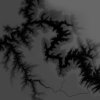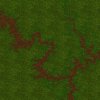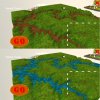tumorhead
Well-Known Member
Anyone use Blender? After avoiding it for...ever, I finally broke down and figured I need to use it to make 3d terrains for little games I'm making, and it actually is really addicting.
In photoshop, gimp, or any 2d drawing program you make a heightmap by drawing various shades of gray which you can use to generate terrain depth. So I like to take a google earth image, and replace the colors in solid shades of gray, then replace the shades with textures and turn it into a world.
So I made a little tutorial this morning recapping what I'm talking about:
I started with this image from the grand canyon I edited a bit:

Where the black will be the lowest part, and the lighest shade will be the top of the canyon.
I copy and replace sections of that in photoshop and replace with copied sections of my textures. (I would have just brushed them on with a layer mask but my brush pattern was pissing me off and not working right.)
Once it's textured you have to flip it both horizontally and vertically.
Which gives something like this:

And when you turn it into a 3d model you get:


I made a video of the steps it takes if anyone's interested:
[video=youtube;AFmMfMOXQLg]https://www.youtube.com/watch?v=AFmMfMOXQLg[/video]
In photoshop, gimp, or any 2d drawing program you make a heightmap by drawing various shades of gray which you can use to generate terrain depth. So I like to take a google earth image, and replace the colors in solid shades of gray, then replace the shades with textures and turn it into a world.
So I made a little tutorial this morning recapping what I'm talking about:
I started with this image from the grand canyon I edited a bit:

Where the black will be the lowest part, and the lighest shade will be the top of the canyon.
I copy and replace sections of that in photoshop and replace with copied sections of my textures. (I would have just brushed them on with a layer mask but my brush pattern was pissing me off and not working right.)
Once it's textured you have to flip it both horizontally and vertically.
Which gives something like this:

And when you turn it into a 3d model you get:


I made a video of the steps it takes if anyone's interested:
[video=youtube;AFmMfMOXQLg]https://www.youtube.com/watch?v=AFmMfMOXQLg[/video]


